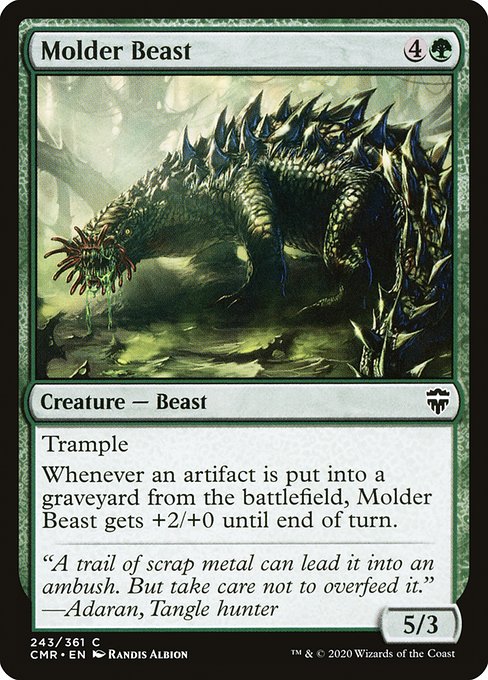
Image courtesy of Scryfall.com
Artist Profile: Randis Albion and the Molder Beast
In the sprawling sandbox of Commander Legends, Randis Albion brings a distinctive voice to MTG art with Molder Beast, a green creature that packs both presence and menace. The card’s mana cost, a sturdy {4}{G}, signals a mid-range threat expected to land with stomping inevitability. The 5/3 body boasts trample, a keyword that invites aggressive play and punishing combat trades, especially when you’re curating a board that loves growth, resilience, and a little chaos. The creature’s flavor of “molder” hints at a fusion of nature and salvage—metal scraps curling into vines, a predator fed by the junkyard of battles past. It’s the kind of design that invites players to imagine a forest that learned to scavenger its own tools. 🧙♂️🔥
Albion’s work on this piece sits at the intersection of lush greenery and metallic grit, a balance that mirrors green’s capacity for growth and green’s occasional willingness to bend brute force into leverage. The Commander Legends frame—colorful, bold, and playful in its drafting innovations—offers a perfect stage for a beast that stomps and scavenges in tandem. The card’s common rarity makes that evocative art even more accessible to players building multi-player decks, where flavor and function walk hand in hand. The art also captures the tactile feel of a world where salvage becomes strategy, a theme that resonates with players who enjoy artifact-heavy builds in Commander. 🎲
“A trail of scrap metal can lead it into an ambush. But take care not to overfeed it.” —Adaran, Tangle hunter
The illustration nods to a lore-rich style that’s common in contemporary MTG storytelling: a creature that’s as much crafted from scavenged pieces as it is born from raw primal force. Randis Albion’s line work and color choices help the viewer read the card’s experimental ecology at a glance. You can almost sense the crackle of metal in the air, the forest’s green pulse beneath the machine’s rust—an image perfectly perched for both casual play and deep-diving discussions about flavor, art direction, and the ways green can hybridize with other thematic motifs in a commander table. ⚔️
Mechanics in the Spotlight: What Molder Beast Brings to the Table
Beyond its eye-catching art, the card’s mechanics give you tangible play options. The beast’s trample ensures it punches through blockers, threatening to push lethal damage when the board is wide or when you’ve packed your list with ramp and mana acceleration. The evergreen interaction—Whenever an artifact is put into a graveyard from the battlefield, this creature gets +2/+0 until end of turn—creates a dynamic that rewards artifact-heavy boards or games with frequent artifact destruction and reassembly. In a green-heavy Commander deck, you can capitalize on artifacts dying to fuel a temporary power spike, turning a single combat into a strategic turning point. It’s a green card that invites players to think about graveyard timing, artifact hate, and the layered economy of resources in a multiplayer match. 🔥💎
Commander Legends’ framing as a “draft innovation” set means Molder Beast arrived in a world where players are often piloting offbeat piles and hybrid strategies. The card’s rarity as common and its foil and nonfoil print options make it a practical pick for casual tables and budget-conscious EDH players who still crave impressive visuals on their boards. The edhrec_rank around 24,429 hints at a broad, accessible footprint in the EDH community—plenty of decks can fit a green behemoth of this flavor and power into their curve. And yes, that’s a lot of green mana math to factor in when you’re plotting a late-game assault. ⚔️
The Artist’s Career Highlights, in Context
Randis Albion’s contribution to this card stands as a reminder of how MTG art weaves together narrative texture and mechanical intent. While a single illustration can’t tell the whole career story, it serves as a vivid milestone within Albion’s broader body of work: a talent adept at rendering creatures that feel both organic and engineered, creatures that invite a second, closer look at how color and texture convey mood. For fans who track the evolution of MTG’s visual language, Molder Beast offers a compact case study in how a single frame can amplify a card’s gameplay identity and its place in a modern, story-forward universe. 🎨
For readers who savor the desk-to-table experience, pairing a card’s artistry with a tactile accessory can elevate the whole session. If you’re grinding mana and planning your next play, a dedicated mouse pad like the one promoted on Digital Vault’s shop page can keep your focus sharp while your battlefield grows wilder. It’s a small but meaningful reminder that the MTG hobby thrives on both imagination and practical setup. 🧙♂️🎲
And if you’re curious to explore more content from the same network and beyond, dive into these insightful reads that cross fantasy, gaming culture, and strategy alike:
More from our network
- https://blog.digital-vault.xyz/blog/post/manor-skeleton-mtg-secondary-market-price-trends/
- https://crypto-acolytes.xyz/blog/post/crafting-as-storytelling-in-survival-games/
- https://blog.zero-static.xyz/blog/post/wrath-of-marit-lage-mtg-forum-sentiment-analyzed/
- https://blog.digital-vault.xyz/blog/post/extremely-reddened-hot-giant-at-2-kpc-traces-stellar-associations/
- https://crypto-acolytes.xyz/blog/post/minecraft-memes-compilation-hilarious-moments-you-missed/